In late April, the McGill Reporter received an email from Carolyn Samuel, Senior Academic Associate, Teaching and Learning Services, about a possible story idea.
“Many people are baking bread these days,” she wrote. “Chris Buddle [Associate Provost (Teaching & Academic Programs)] did a live Instagram session recently (for students) where he showed a beautiful loaf of sourdough that he’d baked. It was received with enthusiasm and lots of calls for ‘Let’s see it again!’ Prof. Ken Ragan (Physics) sent me a photo of a sun-dried tomato sourdough loaf he had baked. I wrote back that it looked like an objet d’art.
“I was wondering if The Reporter would like to put out a call for colleagues’ bread recipes and accompanying photos – similar to the way you call for book recommendations… I’m not a bread baker, myself, but I can nonetheless imagine we could have some fun with this!”
When the call went out for McGill bakers to “get bready to rumble,” creative juices started doughing. Students, staff, faculty submitted their favourite bread recipes in a collective effort that can only be described as the University’s finest flour.
And with that, we bring you the first of two instalments of what we are affectionately calling Loaves in the Time of Cholera. We will post the next instalment next week. If you have a favourite bread recipe, send it (and a picture with you and your creation) to neale.mcdevitt@mcgill.ca.
__________
When told he was the inspiration for the Reporter’s first-ever Get Bready to Crumble Bake-off, Chris Buddle, jumped right in. “Ha! Oh yeah bread time,” he wrote. “Here’s the Story of The Bread:”
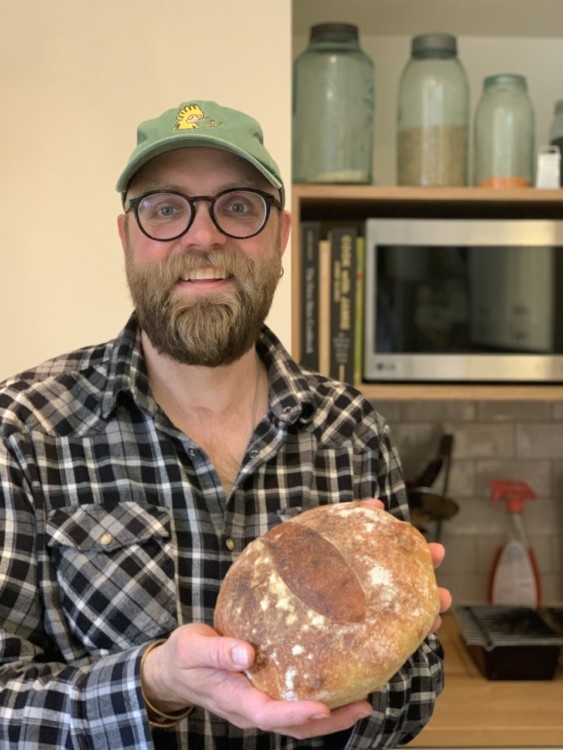
I’ve always wanted to become more skilled at baking bread and the lockdown has allowed me the opportunity and I’m grateful for that. And, while many breads are wonderful, a classic sourdough is, well, simply the best. A good sourdough requires a ‘starter’ and while these are possible and easy to do from scratch, my neighbour (who is an excellent baker!) passed along some of her well established ‘mother’ and I was able to get started quickly. I won’t get into all the technicalities of starters but they aren’t as complicated as you might think (you just grow yeast and bacteria in a jar, feeding them flour and water regularly).
I keep it simple and use the following “baker’s proportion”: for X amount of flour, I use 80 per cent water to that amount, 15 per cent starter, and 2 per cent salt. That’s it – the ingredients are very simple.
Here’s the process: I feed my starter mid-day, and around dinner time I mix up 500g flour (often a mix of standard bread with some whole wheat) with 400 g water (i.e., 80 per cent of 500). After 45 minutes or so, I add in 75g of starter (i.e., after it has done its growing for several hours!) and 10 g salt and mix that up. I ‘stretch and fold’ that gooey mass (note: you don’t knead sourdough bread in the same way as dry-yeast bread) every 30 minutes over a 2-hour period, then let it rise (overnight).
I’m usually awake early so around 6 am I shape the dough on a floured surface, stick it in a basket or bowl to proof for a couple more hours (the second rise), and then bake it (450 degrees, 20 minutes lid on, 20 minutes lid off, 5 min on the rack and out of the pot). I don’t have a Dutch oven so I just use an oven-proof pot. The end result…? Fresh bread for lunch! AMAZING.
While all the above sound time consuming and complicated, it’s really not and you don’t need any special equipment. The whole process to get a loaf takes about 24 hours, but the active time commitment is really quite minimal.
____________________
Christina Zhu, Administrative Coordinator at the McGill School of Environment sent us her take on Alexandra Stafford’s No-Knead Peasant Bread
Ingredients
4 cups (512 grams) unbleached all-purpose flour
2 teaspoons kosher salt
2 teaspoons sugar
2 1/4 teaspoons instant yeast
2 cups lukewarm water, made by mixing 1/2 cup boiling water with 1 1/2 cups cold water
Softened unsalted butter, for greasing
Directions
1. In a large bowl, whisk together the flour, salt, sugar, and instant yeast. Add the water. Using a rubber spatula, mix until the water is absorbed and the ingredients form a sticky dough ball. (If you need to use active dry yeast instead, proof it in the lukewarm water first for about 10 minutes, until foamy, before adding to the other ingredients.)
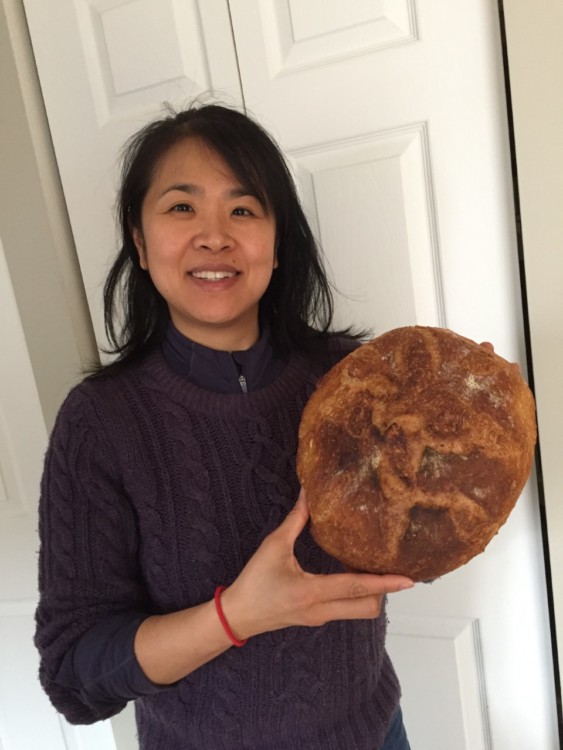
2. Cover the bowl with a damp tea towel or plastic wrap and set aside in a warm spot to rise for 1 to 1 1/2 hours, until the dough has doubled in bulk. Note: Here’s a trick for making the perfect warm spot for the dough to rise. Set the oven to 400° F and let it preheat for 1 minute, then shut it off. The temperature will be between 80° F and 100° F. you should be able to place your hands (carefully) on the oven grates without burning them.
3. Set a rack in the middle of the oven and preheat it to 425° F. Grease two 1-quart oven-safe bowls, like Pyrex (see note below), with softened butter – be generous. Using two forks, deflate the dough by releasing it from the sides of the bowl and pulling it toward the center. Rotate the bowl quarter turns as you deflate, turning the mass into a rough ball.
4. Using your two forks and working from the center out, separate the dough into two equal pieces. Use the forks to lift each half of the dough into a prepared bowl. If the dough is too wet to transfer with forks, lightly grease your hands with butter or oil, then transfer half to a bowl. (If your dough drops and breaks apart on the transfer, don’t worry, just divvy the dough between the bowls and it will come back together as it rises.) Do not cover the bowls. Let the dough rise on the countertop near the oven (or another warm, draft-free spot) for 10 to 20 minutes, until the top of the dough just crowns the rims of the bowls.
5. Transfer the bowls to the oven and bake for 15 minutes. Reduce the heat to 375° F and bake for 17 to 20 minutes more, until evenly golden all around. Remove the bowls from the oven and turn the loaves out onto cooling racks. If the loaves look pale, return them to their bowls and bake for 5 minutes longer. Let the loaves cool for 15 minutes before cutting.
6. Note: If you don’t have 2 one-quart bowls, you may use other vessels, though differences in pan sizes will affect the shape of the final loaves. This recipe can be adapted for 2 loaf pans (preferably 8.5 x 4.5-inch pans) by multiplying the quantities of ingredients by 1.5 (i.e. 6 cups/768g flour, 3 cups water, etc.).
If you want to make this bread more artisan, bake the dough in a preheated vessel introduced by Jim Lahey via Mark Bittman and the New York Times. To give the Peasant Bread the Lahey treatment, while the dough is making its first rise (in a warm spot, but not your oven), preheat a Dutch oven for 45 minutes at 450F. Dust a clean surface with 1/4 cup (32g) flour. Turn the dough out onto the clean surface and shape the dough into a ball using the pinkie-edge of your hands to pinch the dough underneath, creating tension. Transfer the dough to a sheet of parchment paper – the use of parchment paper here is key, as it allows for a seamless transition from the counter to the preheated Dutch oven. After 20 minutes of resting on the counter, remove the Dutch oven from the oven, lower the Peasant Bread, parchment paper and all, into the pan, cover, and bake for 30 minutes. Uncover and bake for 15 minutes more. (Source: Bread, Toast, Crumbs by Alexandra Stafford)
____________________
Ken Ragan, another one of the inspirations for this delicious endeavour, is a professor in the Department of Physics. He sent us the following recipe:
Starter
Mix equal parts whole wheat flour and water and keep on your counter for a week, feed with a tsp of flour and water daily. After a week it should be bubbling and good to go.
About 8 hours before baking (it’s good to do the night before), refresh the starter with 4 tbsp whole wheat flour and equal parts water. It should be bubbling and active at the start.
Bread
3 1/2 all-purpose flour
1 1/4 whole wheat flour
4 tbsp whole wheat starter (see below)
1/2 tsp baker’s yeast
2 cups of lukewarm water
1 tsp honey
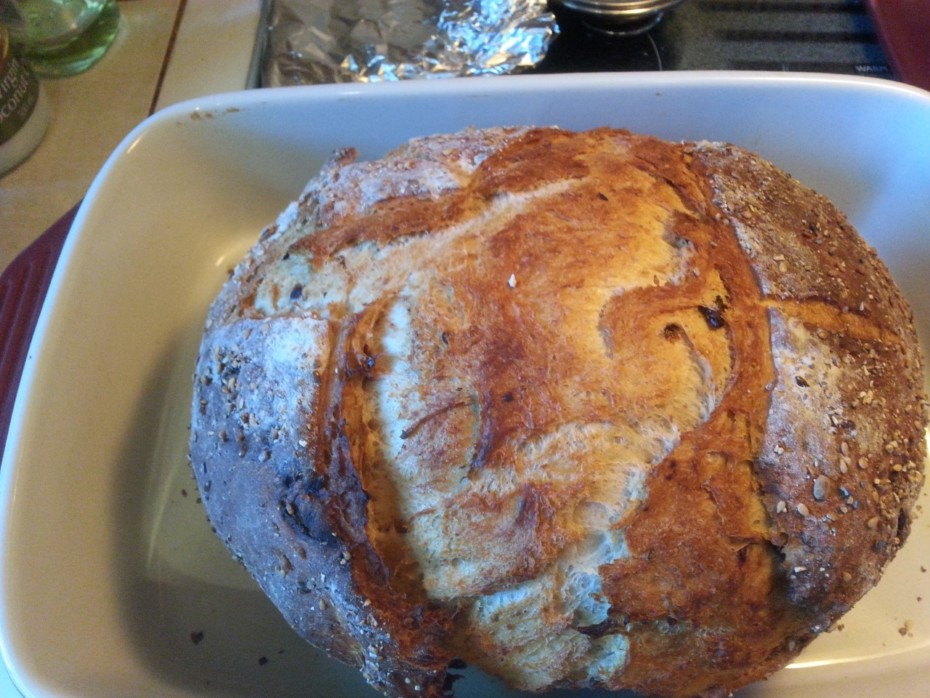
Add yeast, starter and honey to water, let baker’s yeast bloom. Mix water/yeast and flour for 10 seconds to incorporate the flour. Cover with wet towel and put in warm place for about an hour. This is the autolyze part, i.e. no salt.
Dissolve 2 1/2 tsp salt with 1/4 cup water and pour over the dough. Fold the dough over on itself a few times by picking up the edges, pull upward and to the opposite side. Cover with a warm towel and put in a warm place to rise. Every 30 min fold the dough 3 or 4 times (it only takes about 10 seconds each time). Put in a warm place and let rise for 3-4 hours, or in the fridge overnight.
Preheat a cast iron Dutch oven or some heavy sealable dish to 450F. Pour dough into floured surface and fold over four times symmetrically. Then flip over, top should be smooth. Flour as needed.
When pot is hot, place dough in and score with a knife a few times (this will make the crunchy ‘edges’ on the top of the loaf). Seal and bake for 35 min. Then bake for additional 8-10 min uncovered.
Pop out and cool before eating.
Keep the starter in the fridge and refresh the night before you use it. If you’re baking every week, it should be fine.
____________________
“I love baking challah but I use Jamie Geller’s apple challah recipe, modified,” writes Sara Ahronheim, who graduated from McGill Medicine in 2007. “Here is a picture of me and my latest creation, along with a link to her amazing recipe for Round Apple Challah. It was my first attempt at a seven-strand bread.”
Ingredients
Dough
- 1 cup warm water
- 2 1/4 tsp. dry active yeast
- 1/3 cup white sugar + 1 tsp.
- 2 eggs + 1 for basting
- 1 1/4 tsp. salt
- 1/3 cup canola oil
- 1 drop of sesame oil (a “smidge”, to be technical)
- 3 3/4 cups all-purpose flour + 1/4 more for dusting
Filling
- 1 large granny smith apple, thinly sliced
- 3 tbsp. sugar
- 2 tsp. ground cinnamon
- 1 tsp. raw sugar for topping
Preparation
- Add the warm water, yeast and 1 tsp. of sugar to a large mixing bowl. Stir briefly until yeast is dissolved. Wait 10 minutes until the mixture has a foamy layer on top.
-

Sara Ahronheim and her seven-strand apple Challah Add the eggs, 1/3 cup of sugar, salt, canola oil, and sesame oil. Mix well. You can’t clearly taste the sesame oil in the challah, but it adds a hidden delicious flavor.
- Add the flour gradually while mixing until a dough forms. When the dough is too dense to mix with a spoon, use your hands. After all the flour is mixed in, knead the dough for 10 mins. Use the 1/4 cup flour to dust the dough while kneading. It should be a bit wet and sticky. Don’t over-flour it. Place in a greased bowl and cover with a towel. Place in a warm area in your kitchen. Let rise for at least 1 hour or until double in size.
- After the dough has doubled in size, knock it down with your hands to release the air bubbles. Time for the second rise. Let rise for 1 more hour.
- Preheat oven to 350F/175C. On a floured surface, roll out the dough into a rectangle until dough is a 1/4 inch thick. If the dough is too tough to work with, let it rest for 10 minutes then try again. The length of the rectangle should be slightly more than the width. You can trim off extra dough to make it a rectangle. Place a line of apple slices 1/3 of the way from the bottom of the rectangle (see picture below).
- There should be enough space below the apples to fold the dough over them. Sprinkle 1 tbsp. of sugar and 1/3 tsp. cinnamon over the apples. Fold the dough over and repeat two more times. There may only be enough space for 2 rows of apples, and that’s okay. If there is any extra dough at the top, fold it over the rest of the roll.
- Cut the roll into 8 sections. Place each section in a greased bundt pan with the sides facing up & down.
- Place an apple slice between each section. Baste with egg and sprinkle with raw sugar. Rest 45 mins then bake for 30-35 minutes on middle oven rack, or until top is golden to your liking. If you have a thermometer, the challah is ready when the inside hits 185°F/85°C.
_____________________
Duncan Warltier is a PhD candidate in Natural Resource Sciences with Murray Humphries. “Ironically my work focuses on food security,” he says in his email. Here is his recipe for sourdough.
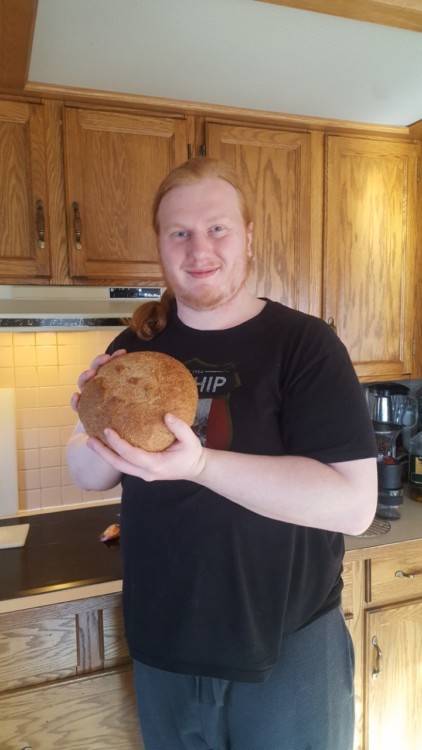
1) Take starter (4-5 years old) out of fridge, add to bowl with 1 cup of flour and 1 cup of warmish water, allow to proof until foamy
2) Add 4 cups flour to activated starter, and enough water to form a supple dough
3) Rest for 30 mins covered
4) Conserve 1/2 cup lean dough, tear into small pieces and add back to culture jar with 2 tbsp flour and 1/2 cup water (this is your starter, DO NOT FORGET THIS STEP, but you can recover from it)
5) Add good pinch of salt and a few glugs of EVOO to dough and knead thoroughly, usually until arm is tired
6) Rest 30 mins, covered, and fold the dough a few extra times, repeat x3 so dough has rested 2 hours total before first rise
7) Add mix ins, I like caraway seeds
8 ) Allow to rise, covered until double or triple in size, but dough isn’t tearing (it will over rise on you and the bread comes out kinda crap)
9) Dust dutch oven with corn meal or preferred grain based stick repellant
10) Lightly punch down and shape dough into ball with seam tucked in at the bottom, drop into dutch oven
11) Allow to double during secondary rise, covered
12) Preheat oven to 450
13) When doubled, slash top of loaf and place in oven with lid on dutch oven , drop oven to 400
14) Bake for 20 mins, then remove dutch oven lid and bake loaf a remaining 30 mins
15) Bake 10 more minutes with oven door cracked
16) Removed from oven, put loaf on cooling rack for 1 hour and enjoy
****
Next week, we’ll post the second instalment of our Loaves in the Time of Cholera series.

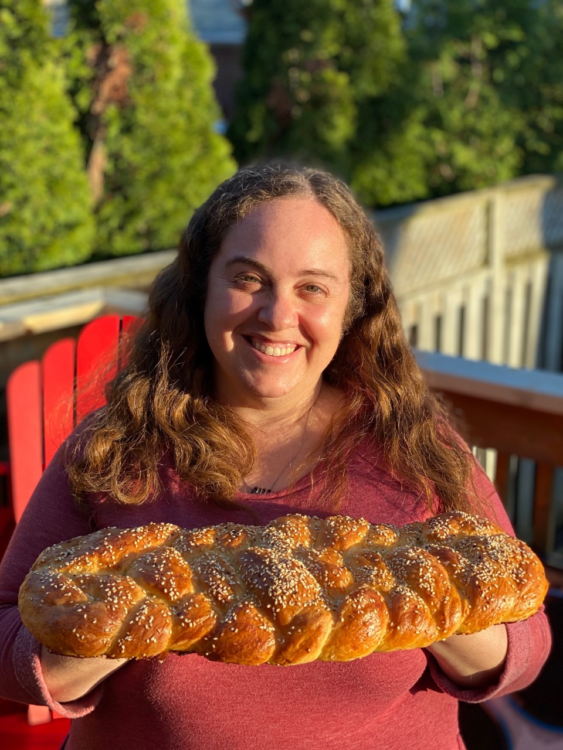
Oooo, Chris, 80% !! You wild and crazy barrier pusher you. I’ve never managed past the 78% frontier myself. I guess that’s what sets academics apart from the rest of us lowly mortals! ?